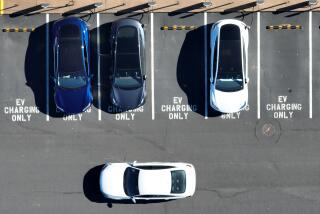State’s Transit Needs in Next Decade Put at $100 Billion
SACRAMENTO — In the next decade, California will need to invest more than $100 billion in its transportation system to cope with a burgeoning population and ease the congestion that has paralyzed its roads in the late 20th century, officials said Wednesday.
Attempting for the first time to inventory California’s transportation needs for the new century, state officials unveiled a list of road and rail projects that include everything from a major widening of Interstate 5 in Los Angeles to improvements to U.S. 101 along the North Coast.
“The needs are staggering,” said California Transportation Commission Executive Director Robert Remen.
And projects proposed for Los Angeles dwarf by billions of dollars anything suggested for any other area of the state.
Transportation officials, who surveyed more than 1,000 government agencies and organizations, acknowledged that their roster represents every group’s wildest wish list, and that the cost of completing such an ambitious agenda is prohibitive.
But they said it will provide a starting point for lawmakers, who are considering a $16-billion bond issue and other measures to fund upgrades of the state’s deteriorating transit system.
“In the main, it tells you that to accommodate the population California is going to get over the next 20 years, it’s going to take a lot of money to keep our transportation system competitive,” said Arthur Bauer, executive director of Californians for Better Transportation, a business and government group.
Remen said officials can choose the projects they consider most critical. All of those on the list are now unfunded; those that are already part of some government plan for completion in the next few years did not qualify for inclusion.
The inventory does not rank the projects by priority, but Remen said it demonstrates what most motorists already know: In the last few decades California’s highway system has not kept pace with population growth.
“The current generations have not done and are not doing what prior generations did to invest in extra capacity for the next generation,” Remen said. “The result of all that is a very, very large need in the short term for additional spending beyond what can probably be handled.”
Ironically, the improved gas mileage of relatively newer cars has taken its toll on the highway system, the survey says, by reducing the gasoline tax revenues that finance the system. As revenues were slipping, it says, the population was growing and motorists were driving ever more miles.
In the survey, one of Los Angeles’ most critical arteries, Interstate 5, is pinpointed for a series of projects to widen the highway from Orange County to just south of downtown and to reconstruct several of its interchanges. The widening would add two additional lanes in each direction, one for carpools and the other for regular traffic.
The inventory also calls for nearly 30 miles of new carpool lanes for I-5 north of downtown.
Other widening projects are listed for the San Diego and Ventura freeways.
Further improvements include closing the gap on California 47 to make the entire length of the highway into freeway, and completing the Long Beach Freeway through South Pasadena.
A high priority for many in the San Fernando Valley--the improvement and widening of the San Diego and Ventura freeways interchange--is targeted at $800 million.
The expansion of Los Angeles International Airport, the survey says, is expected to create a need for $2.4 billion in projects to give travelers easier access to terminals. Among them is the extension of the MTA Green Line directly to the airport and the widening of the Sepulveda Boulevard tunnel, Aviation Boulevard and La Tijera Boulevard at the Century Freeway.
The rail projects listed include several that were stopped by the Metropolitan Transportation Authority last year because of financial problems.
In its contribution to the report, the MTA submitted two lists. The largest called for $18.4 billion in projects for rail and bus transit, highways, city streets and other roads. A second list, which the agency designated as “high priority projects,” totaled about half that amount, $9.4 billion.
“We could have gone on and on and on, but what’s the point?” said Karen Heit, director of strategic policy and planning at the MTA. She said that list was compiled from the agency’s long-range plans and other documents.
On the high-priority list were such projects as the construction of busways across the San Fernando Valley, along Exposition Boulevard and on Crenshaw Boulevard. The building of a controversial subway extension to the Eastside and a subway extension to the Mid-City area also made the high-priority list.
Lower priorities included the Red Line subway extension from North Hollywood to the San Diego Freeway in Van Nuys.
More to Read
Sign up for Essential California
The most important California stories and recommendations in your inbox every morning.
You may occasionally receive promotional content from the Los Angeles Times.









